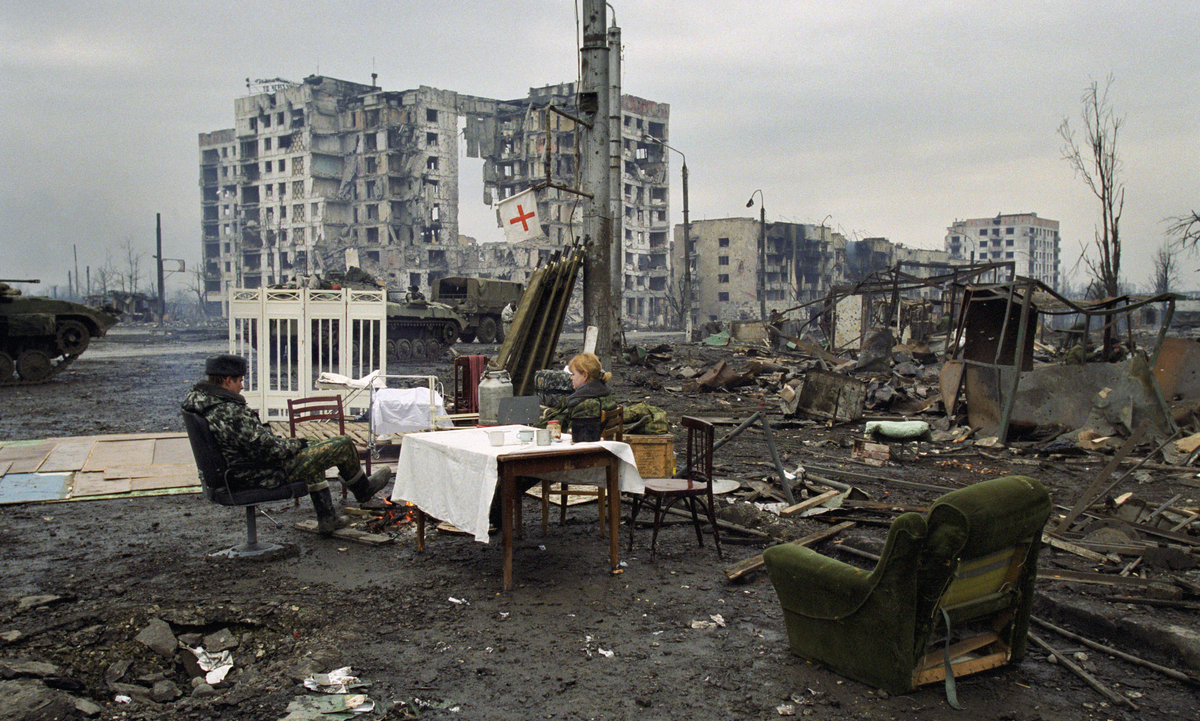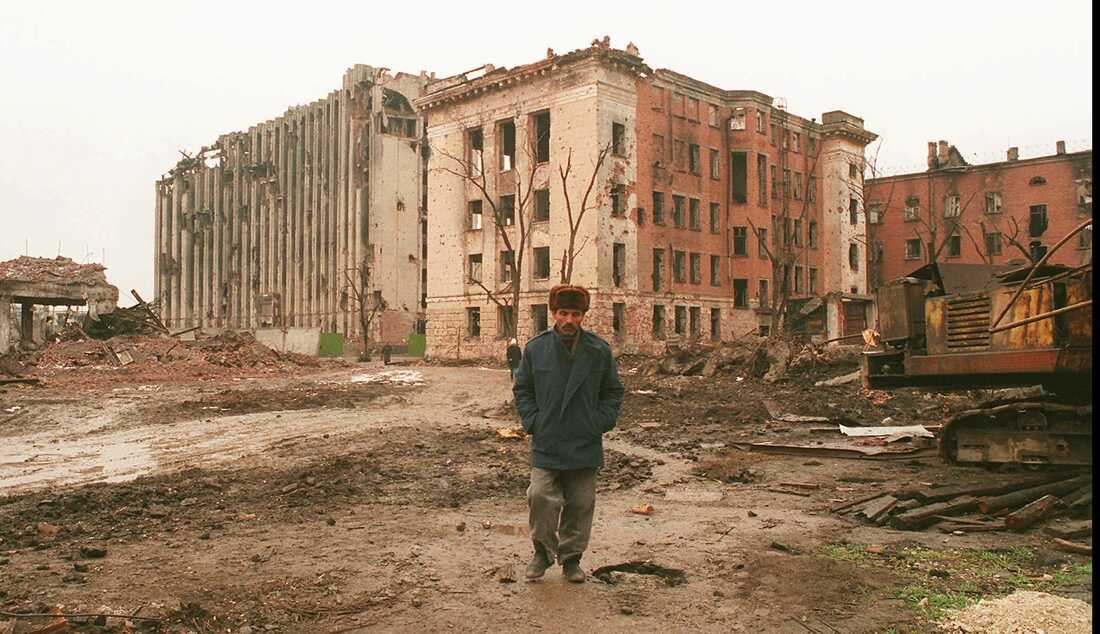[ad_1]

Russian soldiers rest in Chechnya’s capital, Grozny, in February 2000. Russia waged two wars against Chechnya from 1994 to 2000. In both wars, Russia heavily bombed Chechnya, flattening Grozny and causing tens of thousands of civilian deaths.
Dmitry Belyakov/Associated Press
hide caption
toggle caption
Dmitry Belyakov/Associated Press

Russian soldiers rest in Chechnya’s capital, Grozny, in February 2000. Russia waged two wars against Chechnya from 1994 to 2000. In both wars, Russia heavily bombed Chechnya, flattening Grozny and causing tens of thousands of civilian deaths.
Dmitry Belyakov/Associated Press
Russia unleashes a heavy bombing campaign. Cities and towns are reduced to rubble. Thousands of civilians are killed.
Russia did this twice — against fellow Russian citizens — in Chechnya in the 1990s. That raises the question of whether Russian President Vladimir Putin is using the same playbook as he wages war in Ukraine today.
In Chechnya, a tiny Muslim republic in southern Russia with just 1.5 million people, resistance to Russian rule dates back at least two centuries. Rebels there began agitating for independence after the Soviet Union collapsed in 1991.
After a couple of years of increasing tension, Russia unleashed a major invasion marked by relentless airstrikes and salvos of heavy artillery. Thousands of fighters and tens of thousands of Chechen civilians were killed. The Chechen capital, Gronzy, was laid to waste.
Block after block, most every building was completely gutted. No other city had been so intensely bombed for decades. The devastation evoked those black-and-white photos of European cities pummeled in World War II.

Russian President Vladimir Putin flew into Grozny, Chechnya, in March 2000, traveling in a Su-27 fighter jet after Russia recaptured the territory.
AP
hide caption
toggle caption
AP

Russian President Vladimir Putin flew into Grozny, Chechnya, in March 2000, traveling in a Su-27 fighter jet after Russia recaptured the territory.
AP
Russia waged the campaign for two years, with its powerful military trying and repeatedly failing to crush a small band of rebels. Remarkably, Russia lost.
President Boris Yeltsin’s government in 1996 signed a peace treaty with Chechnya, removed all Russian troops from the territory and granted broad autonomy to Chechnya, though not formal independence.
Putin comes to power
But three years later, as Yeltsin was about to leave office, he named an obscure spy turned politician to be his prime minister — Vladimir Putin.
Putin assumed that office on Aug. 9, 1999, and by the end of that month, Russia was waging a renewed bombing campaign against Chechen rebels in an attempt to reverse the earlier humiliation.
The second Chechen war was also brutal, though it proved more effective. Russian forces took control of the breakaway republic after just a few months.
In March 2000, a triumphant Putin, who had by this time become president, flew to Grozny in a Russian fighter jet. He emerged from the aircraft in a full pilot suit, to commemorate the victory.
Putin installed a Kremlin-friendly leader, Akhmad Kadyrov, to strengthen his hold of the territory. Kadyrov was assassinated in 2004, but his son, Ramzan Kadyrov, now rules Chechnya.
In the current battle in Ukraine, Chechen forces have been sent in to fight with the Russian military.

A Chechen man walks across a square at the Presidential Palace in Grozny in January 1996. Russia heavily bombed Chechnya during its 1994-96 war there. Russia lost that war and signed a peace treaty, agreeing to leave Chechnya and giving the territory autonomy, though not formal independence. Russia reinvaded Chechnya in 1999.
Mindaugas Kulbis/Associated Press
hide caption
toggle caption
Mindaugas Kulbis/Associated Press

A Chechen man walks across a square at the Presidential Palace in Grozny in January 1996. Russia heavily bombed Chechnya during its 1994-96 war there. Russia lost that war and signed a peace treaty, agreeing to leave Chechnya and giving the territory autonomy, though not formal independence. Russia reinvaded Chechnya in 1999.
Mindaugas Kulbis/Associated Press
Parallels between Chechnya then and Ukraine now
Thomas de Waal, a journalist who covered Chechnya in the 1990s, said he sees many similarities between then and now.
“There are some pretty disturbing parallels,” said de Waal, who’s now in London with the Carnegie Endowment for International Peace. “The use of heavy artillery, the indiscriminate attacking of an urban center. They bring back some pretty terrible memories for those of us who covered the Chechnya war of the 1990s.”
There are political parallels as well, he said.
“There was a project to restore Chechnya to Russian control, and nowadays in 2022, to restore Ukraine to the Russian sphere of influence,” said de Waal. “And there was no Plan B. Once the people started resisting, which came as a surprise in Chechnya and is coming as a surprise in Ukraine, there was no political Plan B about what to do with the resistance.”
He said Putin was expecting little or no pushback, as happened when Russian troops quickly and bloodlessly seized Ukraine’s Crimean Peninsula in 2014. Instead, Putin got Chechnya, 1994.
After more than two weeks of heavy fighting in Ukraine, the Russian invasion is moving far more slowly than planned.
With their superior firepower, Russian forces are closing in on Ukraine’s cities. But the Ukrainians are still resisting fiercely and still hold the capital, Kyiv, and other large urban centers.
Meanwhile, the civilian toll is mounting.
“When Russia says that it is ‘not waging war against civilians,’ I call out the names of these murdered children first,” Ukrainian first lady Olena Zelenska said in an open letter this past week. “Perhaps the most terrifying and devastating of this invasion are the child casualties.”
At least 549 civilians have been killed and nearly 1,000 injured, according to the U.N. Office of the High Commissioner for Human Rights. The actual number could be much higher, according the office.
“Schools, hospitals, and kindergartens have been hit – with hugely devastating consequences,” the U.N. body said in a statement. “Civilians are being killed and maimed in what appear to be indiscriminate attacks, with Russian forces using explosive weapons with wide area effects in or near populated areas.”
U.S. intelligence officials painted a bleak picture this past week, predicting that urban fighting in the coming weeks could be even more intense.
Director of National Intelligence Avril Haines, testifying Thursday before the Senate Intelligence Committee, said, “Our analysts assess that Putin is unlikely to be deterred by setbacks and instead may escalate, essentially doubling down.”
Greg Myre is an NPR national security correspondent. Follow him on Twitter: @gregmyre1.
[ad_2]
Source link



